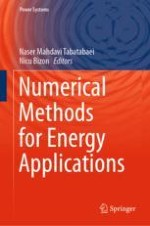Abstract
Classically, the solution to contour problems in electromagnetism was based on analytical techniques, looking for closed solutions. The solution, whether computational or analytical, of electromagnetic problems is extremely important for analyzing the interactions of wave emitting and receiving devices among themselves and with their environment, including both inanimate dispersing objects and living beings. There are many applications in various areas: radio frequency antennas, radar, optics, wireless communications, imaging in bioengineering, nanotechnology and metamaterials, electrical substations, etc. Such analytical or computational solutions are particularly useful to increase productivity in all these well-established areas, to provide procedures to improve existing designs before actual implementations and to facilitate the design of new processes and devices. Typically, electromagnetism problems can be formulated using Maxwell equations. However, the Maxwell equations only admit an analytical solution for some dispersing or emitting objects with canonical geometric shapes, such as the sphere, the infinite plane, elemental antennas, etc. Numerical methods broaden the spectrum of known solutions which, while to be considered approximate, in many cases can be selected to what level of precision the calculated results describe the physical reality being analyzed. In recent decades, driven by the availability of increasingly powerful computers, the area of computational electromagnetics (CEM) has experienced a remarkable increment as an area of research. Mathematical formulations of physical electromagnetic problems produce systems of equations that can now be solved numerically by computers. Thanks to advances in computational technology and increasingly sophisticated mathematical algorithms of electromagnetic modeling, it is a reality to simulate radiation or scattering problems containing arbitrary and complex structures for which there is no analytical solution to the Maxwell equations. There are various methods of computational electromagnetism and various classifications. Depending on the geometric model used by their formulations to characterize the dispersers, they can be classified into three types: ray tracing, surface discretizations, and volume discretizations. Depending on the precision achieved in the results and the field of application, they are classified into full-wave and asymptotic methods, also called low and high-frequency methods. Methods based on volumetric discretizations, such as finite-difference time-domain (FDTD) and frequency domain finite-element method (FEM), have the advantages that they allow for easy modeling of non-homogeneous media, and their associated 3D mathematical formulations are relatively simple. However, they suffer from the fact that the resulting system of linear equations has a number of unknowns proportional to the simulated volume, so the computational demand grows very rapidly as the electrical dimensions considered in the simulation increase. The methods based on discretizations of surfaces present characteristics that make them computationally more efficient than the volumetric ones. The formulations used in surface methods are based on surface integral equations (SIE) which, unlike volumetric formulations, are mathematically more difficult to implement in a computational code, partly due to the various types of singularities of the Green function. Another disadvantage of this type of methods is the impossibility of simulating general non-homogeneous means, although they have the great advantage that they only require discretizing the interfaces, that is to say, the two-dimensional surfaces that delimit the dispersing objects. Among the surface methods, the method-of-moments (MoM) and its computational optimizations stand out, in exchange for introducing a controllable numerical error on the results of the pure MoM, known as fast multipole method (FMM) and multilevel fast multipole algorithm (MLFMA). The physical optics (PO) is also considered as a surface method based on SIEs since it is based on surface discretizations, although using approximations valid only for electrically large objects. The PO supports a correction method to include diffraction, called physical theory of diffraction (PTD), although this correction is only applicable to perfect electric conductors (PEC). In this chapter, we will analyze some of the numerical methods used in electromagnetism.
